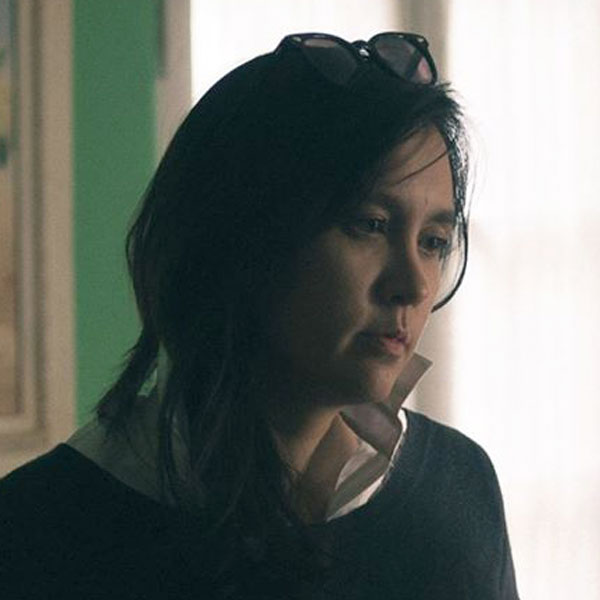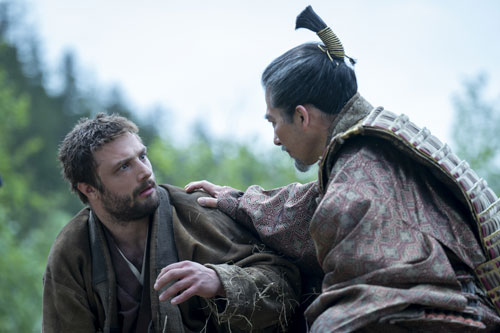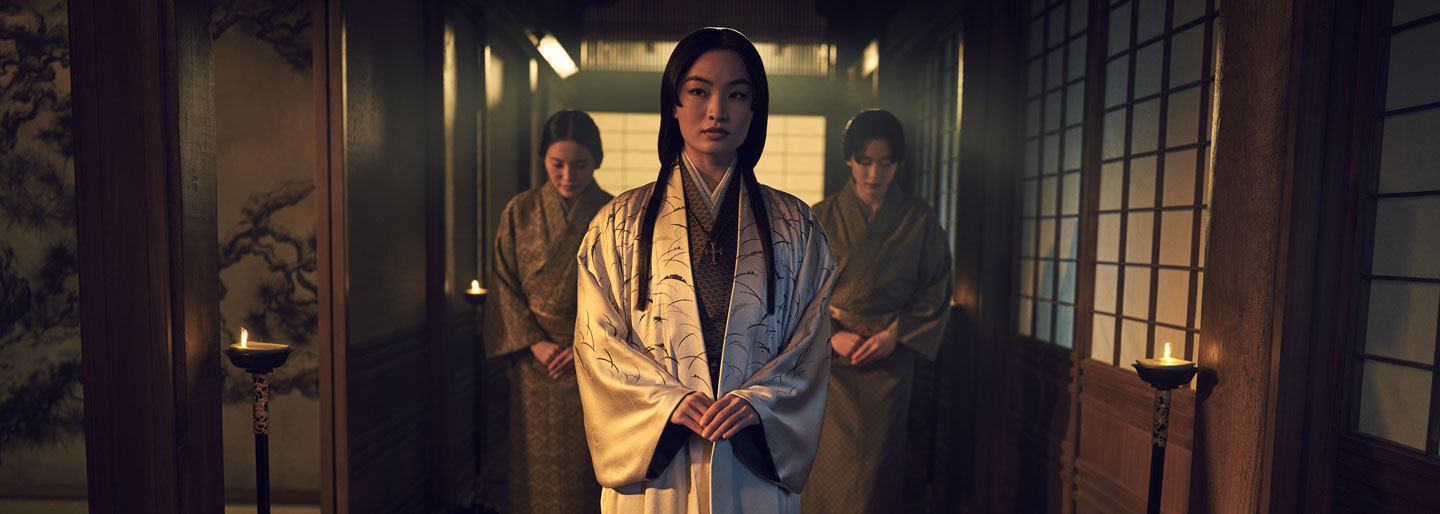So who was the ultimate playmaker and who was being played? Blackthorne is threatening to do what? All those men talking! And what’s the deal with the old man and those anxious-looking little white children at his bedside?
Viewers have been debating the nuances of the conclusion of Shōgun since the FX series, based on the novel by James Clavell, concluded its 10-episode first season in April. Water cooler talk can get heated when a much-loved novel is adapted for the screen, but WGAW members Maegan Houang and Emily Yoshida—who co-wrote episode 10, “A Dream of a Dream”—said, “Bring it on.”
 Emily Yoshida. Photo by Katie Shapiro
Emily Yoshida. Photo by Katie Shapiro“It shows how invested people are in the story,” Yoshida said, “and I think it’s just a dream whenever you make something for other people who care about it, because that doesn’t always happen, and it’s not really in our control. So if anything, it’s just an honor that people care so much about the work that we did.”
Although they had friends in common, Houang and Yoshida did not know each other before joining the Shōgun writers’ room more than four years ago as story editor and staff writer, respectively. Houang had been a writer’s assistant to co-creator-showrunner-executive producer Justin Marks, and later a staff writer on the series Counterpart, which Marks created. Shōgun was the first writers’ room for Yoshida, whose feature screenplay came to the attention of Marks through a professional acquaintance. Once on team Shōgun, Houang and Yoshida found much to bond over. The chance to co-write the finale of the series was both an exciting opportunity and the culmination of a writers’ room that the two writers agreed was notable for its collaborative spirit.
“Even though Emily and I were technically the lowest-level writers on staff, we definitely felt comfortable with everybody pitching ideas and everybody contributing,” said Houang. “We were both really excited to get to do the finale together, because it was a pretty fun episode to write.”
 Maegan Houang. Photo by Ben Kuller
Maegan Houang. Photo by Ben Kuller“And a heavy lift,” added Yoshida. “In almost any universe, that would be a two-person job, because there is so much story in the finale that is condensed to a couple of really key scenes.”
For season 1, Marks divided Clavell’s novel into sections, and the room would collectively break an episode before assigning the script. In addition to co-writing episode 10, Houang and Yoshida each had a writing credit on a different episode of the series.
Divvying up the storylines of episode 10, Yoshida and Houang each wrote an equal number of scenes. Then they combined their pages, gave each other notes, and streamlined the script. It was a similar process to the one that Houang and Marks had followed in co-writing the finale of Counterpart.
“I had never co-written anything in my life before, so I thought, How is this going to work?” Yoshida said. “I thought it worked out great.”
Houang and Yoshida were writing “A Dream of a Dream” as other writers were concurrently working on episodes 7 through 9. They were able to review detailed outlines of the events leading up to their story. And of course, they had the novel. During the interview, Houang held up her well-worn volume of Clavell’s 1975 best seller, which was bulging with Post-it notes. Clavell’s Shōgun may have been the inspiration for the series, but the writers were permitted to take creative risks, particularly in the later parts of the story. Where the early episodes hew more closely to the book, “A Dream of a Dream” takes some significant detours.

Coming from two cultures and balancing that in your mind is so much a part of the story of Shōgun, Mariko has the line, ‘I have more than one heart.’ Even though we’re not living in medieval Japan, we can speak to the experience of having to contend with double identities.
- Emily Yoshida
Among them are the framing device, which can be interpreted as a dream or a flash-forward, the laying out of Lord Yoshii Toranaga’s plan, and the relocation of John Blackthorne’s offer to commit ritual seppuku. The two writers wrote a lengthy dialogue scene among council members that they worried might lose viewers.
“Emily and I would have conversations of like, ‘This is hard,’ because we didn’t have the book as much to support us, so we had to talk through scenes a lot more specifically for this episode than in the first half of the season,” Houang said. “We have a lot of reverence for the source material. It’s an incredibly compelling story, but the goal was to give it a fresh update and justify why it was being made. It was important for Justin to have people of a younger generation who are familiar with the book put our own spin on it.”
“For me personally, when I tell anyone in my family over 50 or 60 years old about it, they know and love Shōgun,” she continued. “Most people not in that age group haven’t heard of it. We needed to be able to adapt it to modern times.”
 Cosmo Jarvis and Hiroyuki Sanada in "A Dream of a Dream," the season finale of Shōgun. Photo by Katie Yu/FX
Cosmo Jarvis and Hiroyuki Sanada in "A Dream of a Dream," the season finale of Shōgun. Photo by Katie Yu/FXAlthough the story’s central plotline tracks Englishman Blackthorne’s adaptation to life in feudal Japan, the writers noted that the series is told largely from the points of view of Japanese characters, necessitating, among other things, extensive dialogue in Japanese with subtitles.
“This is an international show and very much a Japanese production, but it’s also an American show, and I think Justin wanted it to have an Asian American perspective as well,” said Houang, “because that’s very distinct from a Japanese or just a pan-European American white perspective.”
That perspective and key themes of the story resonated with Yoshida and Houang, who share similar cultural backgrounds. Both were raised in the Midwest, the daughters of Asian fathers and white mothers.
“Coming from two cultures and balancing that in your mind is so much a part of the story of Shōgun,” said Yoshida. “Mariko has the line, ‘I have more than one heart.’ Even though we’re not living in medieval Japan, we can speak to the experience of having to contend with double identities.”
“We kind of grew up as outsiders within our own community,” Houang agreed. “Whether we’re young little Asian girls in a predominantly white space, or we’re like half-Asian girls visiting our family where your family is like, ‘You look like your mom,’ we have a very strong perspective that way that really coincides with the themes of the source material in the show.”
Yoshida and Houang, who have both been asked back for the second season, said they expect to return to a creative landscape that the 2023 WGA strike helped improve for writers of all levels. They pointed out that, even pre-strike, Shōgun’s writers’ room set a high bar due to the size of the room and the spirit of collaboration.
“If anything, I hope the success of Shōgun reminds studios and audiences the power of a room and how much deeper and richer your show can be when you have more voices that are listened to,” Houang said. “I’m very optimistic we can continue the strength of the show as a group together, because it really is a team effort.”
“I feel like the audience can sense the fact that so many people worked together, and that’s what’s appealing about the show,” added Yoshida. “It just feels like a collaborative vision that came together in a beautiful way.”
Marks agreed.
“To me, the success of Shōgun, from a place of story, was entirely derived from the unique group of writers who worked in the room with us," Marks said. "Maegan and Emily are great examples of writers who don’t ordinarily come out of this genre. They each have a modernity to their approach and an awareness of how a story like ours would sit in the modern world. This allowed us to subvert and surprise at every turn. I feel like the finale is the ultimate example of this approach, which is why they made such a great pair to write it.”






